|
Austin, Martin, Hopwood, and Holtzclaw and Others.
Our Austin Line:
Southern
Campaign American Revolution Pension Statements
Pension application of John Austin R318 fn62Va.
Transcribed by Will Graves
Revolutionary Claim For the
purpose of obtaining the benefit of “An Act for the relief of certain
Surviving officers and Soldiers of the Army of the Revolution” approved on
the 15th of May 1828,
I, John
Austin of the County of Oldham and State of Kentucky do
hereby declare that I entered the Continental line of the Army of the
Revolution for and during the War and continued in its service until its
termination at which Period I was a Private in Captain Porterfield's Company
until the Rendezvous at Middlebrook in the Jerseys. I was transferred to
Captain Gabriel Long's Company who was arranged [sic, attached?] to
Col.
Daniel Morgan's Regiment. I was some times under the command of Colonel
Slaughter, Lieutenant Colonel Butler and Major Morris who was killed at the
White Plains, Benjamin Ashby was part of the time our Paymaster.
I was
acquainted with Captain John Marshall now Chief Justice of the United [States] and sent my discharge to him in
Richmond Virginia to effect a Settlement for me and it was lost by Mr.
Picket.
I also declare that after my discharge I received a
certificate for the reward of $80 to which I was entitled under a resolve of
Congress passed the 15th of May 1778 and I further declare that I was not on
the 15th of March 1825 on the Pension list of the United States.
S/ John Austin, X his mark
[John Sage gave the standard supporting affidavit of
reputation and belief.]
Oldham
County Kentucky September 20, 1828
The Honorable Richard Rush Secretary of the Treasury of
the United States
Sir. I had been informed of the Law providing for the
surviving revolutionary soldiers some time ago, but being now very ancient
and bad health, has delayed my sending you my Declaration it is now
forwarded enclosed.
I was with General Morgan at the Battle of the Cowpens
and my Captain Gabriel Long was not with us at that battle the Lieutenant Ephraim Long
commanded us this was the last Battle I was in to the South Captain Gabriel
Long commanded the Company at the Siege of York. Please write me to LeGrange
Oldham County Kentucky.
Your
Obedient Servant,
S/ John Austin
Oldham County near LeGrange Post Office Kentucky 4
September 1829
Sir. I lately forwarded to you the evidence of John
Allen1 in support of my claim under the Act of 15th May 1828 making
Provision for the Surviving officers & Soldiers of the Army of the
revolution. Since which I have been favored with a list of the survivors who
have been found untituted [sic, entitled?] in which I discover the name of
Reuben Long a Lieutenant of the Virginia line. I had been impressed with the
opinion that my Lieutenant's name was Ephraim Long but believing it possible
that in the given name I may have been mistaken. I now enclose to you a
letter to the address of Reuben Long wish you will please forward if the
evidence already furnished may not default sufficient.
Permit me served to observe to you that I was with
Morgan at Québec which will discover to you that I am very anxious and am very infirm.
I have the honor Served to be your obedient Servant.
S/ John Austin
Received 31st of August 1829
1 This may be a reference to John Allen FPA S30818 who
filed an application in Woodford Co., Ky., claiming service under Daniel
Morgan in the Virginia line.
State of Kentucky Woodford County
This day came John Allen before me
Bernard Gaines a
Justice of the Peace, in & for the County of aforesaid, and made Oath in due
form of law: That he was a private Soldier in Morgan's Rifle Regiment during
the War of the revolution in which he served four years; during which time
he became acquainted with John Austin, who was also serving
as a private in the same Regiment, and Served together about two years, were
both at the taking of Burgoyne, and continued together until General
Sullivan was ordered to March against the Indians (Generally called
Sullivan's expedition;) when all those who had enlisted for during the war
were ordered to March with him General Sullivan and that John Austin
went with them and he Allen staid behind having enlisted first for one and
then three years only.
That he always understood from his first becoming
acquainted with Austin and that he was enlisted for and
during the War, and verily believes he was. Further this Deponent saith not.
S/ John Allen, X his mark, of Glens Creek
Sworn to and subscribed before the undersigned the 11
day of August 1829
S/ B.
Gaines, JPWC
State of Kentucky, Oldham County
On this 20th day of August 1832 personally appeared
before the County Court of Oldham
Edward M. Taylor a Justice of the peace in the County
and State aforesaid, John Austin Jr., a resident of Oldham
County and State of Kentucky aforesaid aged 96 who being first duly sworn
according to law, doth on his oath, make the following declaration in order
to obtain the benefit of the provision made by the act of Congress passed
June 6th [sic, 7th] 1832.
That he enlisted in the Army of the United States
in the year 1785 [sic, 1775?] with Captain Daniel Morgan as a private and
served in the 11th Regiment of the Virginia line under the following named
officers: __ [blank in original] Butler being the Colonel, Benjamin Morris
Major he does not recollect the names of the other company and field
Officers, he enlisted under Captain Daniel Morgan as aforesaid for the term
of three years in the year 1775, he then resided in the County of Fauquier in the State
of Virginia and continued in service until the expiration of his
term of enlistment, when he enlisted with Charles Porterville [sic,
Porterfield] as Captain for during the war in Col. Daniel Morgan's
Regiment of Rifle men in the Virginia line and continued in the
service until the end of the war – he was in the battle of Still Water [sic,
Stillwater], Monmouth Courthouse, White Plains and the Cowpens.
He marched
from Winchester Virginia to Québec, from thence to New Jersey, from thence
to Connecticut, and from thence to Pennsylvania, from thence through
Virginia & North Carolina to South Carolina, thence to Georgia and on his
return was at the Siege of York and was discharged in 1782 receiving his
certificate of discharge from General Morgan in Frederick County State of
Virginia – he further states that Charles Porterville [sic, Porterfield] was
promoted to the Rank of Major when Gabriel Long became his Captain – and
continued so until he was discharged. He hereby relinquishes every claim
whatever to a pension or an annuity except the present and declares his name is not on the pension roll of the
agency of any State.
Sworn to, and subscribed the day and year aforesaid.
Test: S/ I R Gwaltney S/ John Austin,
X his mark
State of Kentucky, Henry County
On this 18th day of November 1846 came before (in
the Town of New Castle and County aforesaid) me a justice of the peace for
said County of Henry, Henry Browning a Citizen of said County and a person
of undoubted character for truth and moral & Christian behavior and whom I
have known to be such and said Browning made oath, that in the fall of the
year 1784, John Austin late a pensioner of the United
States, and Elizabeth Lindsey (said Elizabeth being his half sister) left
the house of the Mother of said Henry Browning, with their marriage Company
in order to be married at a
neighboring church; that the said John Austin and Elizabeth
Lindsey, returned with their Company to his mother's house the same evening,
as man & wife – and that he is confident that they had a license to be
married and were lawfully joined in lawful wedlock – the mother of Elizabeth
Lindsey and this affiant were the same person – that they lived together as
man & wife until the year 1845 when in October Mr. John Alston died – that
his mother recognized Mr. John Alston as her son-in-law and he and all
friends & connections did likewise – Indeed that they were man & wife
legally married for many years and always so considered.
Sworn to & subscribed before me date above.
S/ Thos. B. Posey, JP HC S/ Henry Browning
State of Kentucky Oldham County 20th of March 1830
I hereby certify that somewhere about the year 1822 as
well as I recollect Jesse Wilhoyte a revolutionary Soldier came to my house with John
Austin to prove the said Austin's service
in the revolutionary war which he said Wilhoyte made oath to before me and
stated that he was well acquainted with said Austin in
Morgan's Regiment that they were in the Company commanded by Captain Gabriel
Long from Culpeper County Virginia. I being at that time and for some years
before and since an acting Justice of the Peace for the County of Jefferson
Kentucky – but kept no record of said Wilhoyte's oath and cannot state with
precision the exact time; the said Jesse Wilhoyte is since dead.
Given under
my hand the date above.
S/
Richard Barbour
|
But sine this is about “the
Road”, I am getting ahead of my story. The “ Old Military Road”
begins at Palmyra. Someone may say, “But, I though all roads in
Northeast Missouri lead to Hannibal. That’s true, but the road from
Palmyra to Hannibal was cut through before the Old Military Road was
authorized.
At the top of the hill,
where Palmyra Avenue ends and “the road” begins stands Morgan’s
Tavern. John Morgan is a descendant of General Morgan of
Revolutionary fame, in whose regiment of sharp
shooters, John Austin, father of
John Frazier Austin of Ralls County and
grandfather of John Sanford Austin of Monroe County,
marched and fought.
And it was a long march from Virginia to New
York, where they persuaded the British General Burgoyne to surrender
and back south to North Carolina, then to Virginia again. And George
Blakey after crossing the Delaware River with General Washington and
helping in the taking of Trenton and Princeton, also joined the
regiment. For defeating a superior force of the English in the
battle of Cowpens, in N. C., in 1781, Congress voted General Morgan
a gold medal. The general would have been the first to say but for
the bravery and discipline of his men, it could never have been
done. John Austin died, only a few years ago, in 1845, in Oldham
Co., Ky., aged 109 years and George Blakey, aged 93, died three
years earlier in Logan Co., Kentucky.
At Morgan’s Tavern, three roads meet, the road
to Hannibal the earliest; the road to Shelbyville and on through the
county seats to the west; and the old military road, cut through
about 1835. Starting at Palmyra, it traverses Monroe, Randolph and
Howard Counties; crosses the Missouri River at Boonville; runs thru
Cooper, Pettis and Benton Counties; crossing the Osage at Warsaw,
thence south through Springfield, Mo., Fayetteville and Ft. Smith,
Ark., to Texas.
|
John Austin, having united in marriage with Nanie
Elizabeth Kipper, the couple will furnish a wife to Fred Blakey, as yet an
unborn son of Marcus and Patsy. Per above, sons of John Austin
and Elizabeth Lindsy must have migrated to Missouri; perhaps James and John.
Names of children of Austin:
Daniel Austin, aged 52 in May 1850. William Austin, nine years older
than Daniel. Lucy Austin, seven years older than Daniel.
James Austin, four and one half years older than Daniel. John Austin,
two years older than Daniel.
Joseph Shirley born Nov 2, 1821 married Lucy A. Austin
Aug 1, 1846 in Oldham Co. KY
BIOGRAPHY: Jane Edmonia Shirley is the
granddaughter of James Austin and Elizabeth Deel; great granddaughter of
John Austin and Elizabeth Lindsay. John Austin [1736-1845] served as a
private in Morgan's sharpshooters in the Revolutionary War. He died in
Oldham Co, KY. NSDAR ID NUMBER: 21991. Also refer to 5000, 14033,
and 20326.
Oldham County, KY Veterns
| Austin, Daniel |
Capt. Joseph Funk's Co. of KY
Detached Militia |
11/10/1814 - 05/10/1815 |
Pvt. |
| Austin, George (aka James) |
Capt. Bland Ballard's Co., 1st Rifle Regiment, KY
Militia |
08/15/1812 - 10/14/1812 |
Pvt. |
| Austin, James |
Capt. Joseph Funk's Co. of KY Detached Militia |
11/10/1814 - 05/10/1815 |
Sgt. |
| Austin, William |
Capt. Joseph Funk's Co. of KY Detached Militia |
11/10/1814 - 05/10/1815 |
Pvt. |
JOHN AUSTIN OLDHAM COUNTY PRIVATE VIRGINIA LINE $80.00
ANNUAL ALLOWANCE $240.00 AMOUNT RECEIVED NOVEMBER 6, 1832 PENSION STARTED
AGE 98.
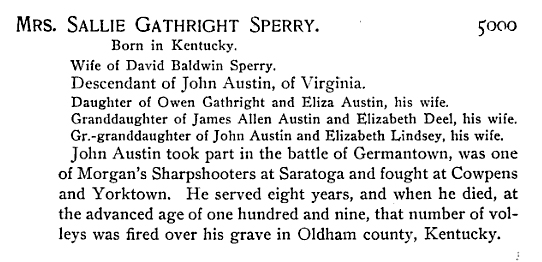

MARTIN, Eliza Gathright (Mrs. Clarence L.
Martin), 749 S. Second St., Louisville, Ky.
Born Oldham Co., Ky., Oct. 20, 1847; dau. Owen and Eliza Ann
(Austin) Gathright; ed. Louisville Girls' High School, 1864
(valedictorian of class); m. July 1, 1879, Clarence Linden Martin;
children: Clarence L., Owen Gathright (twins)Taught 1864-79. Was
offered chair of mathematics, Girls' High School; declined. Favors
woman suf- frage. Mem. Relief Union, Church Ass'n Charities,
Salvation Army, Children's Home* Sinking Soc, Humane Soc, Am. Home
Economics Ass'n, Filson Club (historical soc. of Ky. for research
work). Christian (Disciples of Christ). Democrat. Recreations:
Reading, painting, cards, mu- sic, drama. Clubs: Alumnae, Girls'
High School, Ky. Fed. of Women's; chairman Dep't of House- hold
Economics; Com. Tax of Household Economics of Gen. Fed. Women's
Clubs. Has charge of Southern States. Leader in discussion of ex-
tension work by clubs at the conference of Household Economics at
Biennial of Gen. Fed. of Women's Clubs, San Francisco, June 25-July
5. 1912. |
Austin Cemetery, Oldham Cty, KY
The Austin-Page Cemetery is located on Shiloh Lane, a
short distance past the end of the divided portion of Shiloh Lane. The
cemetery is visible on the left of Shiloh Lane and is located in the side
yard of privately owned property. The cemetery was established on the
property of John Austin in mid 1800's and several members of the Austin
family were buried here.
The land was bought by Richard Waters and he gave
the property to George William Page, a freed slave of the Henshaw-Waters
plantation. The Austin's were later reinterred at Cave Hill Cemetery in
Jefferson County, Kentucky. 1859 was the earliest burial found.
N 38° 25' 53.6'' W 085° 32' 48.8''
Birth: Apr.
13, 1791 Oldham County Kentucky, USA Death: Oct. 3, 1879 a soldier in the
War of 1812, and served under General Andrew Jackson at New Orleans The
Austins have an interesting family history, ... They were among the earliest
colonists of America, and the military record of the family is an enviable
one, as its representatives have been participants in all the wars waged by
the colonists and their successors.... Moved from family and
reburied:12/7/1896 (story has it, after Eliza Austin Gathright died.. farm
was sold.. and family graves moved here) moved and reburied 12/7/1896 was a British soldier in the French and
Indian War, and later a Revolutionary soldier in the Colonial
Army. He served under General Daniel Morgan at Saratoga, and at
the Cowpens, in the regiment of picked riflemen which General
Burgoyne declared was "the finest regiment in the world." He was
also a participant in the battle at Germantown and was with the
forces to which Cornwallis surrendered at Yorktown, having
served during the entire war to establish the independence of
the colonies. This noted old veteran of the Austin family lived
to be one hundred and nine years of age, and at his death in
1845 was buried with military honors befitting he patriotism and
historic achievements.
Burial:
Cave Hill Cemetery
Louisville
Jefferson County
Kentucky, USA
Plot: SECTION 5, Lot 180, Part , Range ,
Grave *5-A
First Generation

Our
known line begins with John Austin, the one above I'm
speculating, born in 1736 and married
Elizabeth Burgess and second to
Elizabeth Browning, in 1786 and then possibly to Elizabeth
Lindsey? Most, if not all of his children were Elizabeth Browning's.
By Elizabeth Burgess he had George
Austin born in 1784; Elizabeth Burgess died and John remarried in
1788 to Elizabeth
Browning, b. circa 1770, she was much younger than
John Austin, her husband. Elizabeth died May 2, 1848, and John died in
1845, both, presumably, in Oldham county, KY.
Shelby County, KY Records: An indenture dated April 1, 1803 of John
Austin of Shelby County that "puts his son George Austin apprenticed to George Shelladicy for 4 years. Among other things,
George
Austin is "not to commit fornication nor contract marriage" during his service.
There are a couple of John
Austin's in the Shelby county, Kentucky census (1820, 30 40 & 50).
George is more than likely the child by
his John's first wife, and then his father married a much younger woman than
George's mother. The new wife and John Austin hadten children
together. He was 19 yrs old in 1803 and perhaps needed a push to
get going in life. Or, perhaps he was going with a girl his
father disapproved of and was trying to prevent their being together.
He would have been released from his
indenture in 1807 and he was married to Frances Martin in 1808, Shelby
County, KY, and his first child John, was born in 1809.
They had known child: George Austin, this is our line, more below.
John and
Elizabeth Browning had:
| i |
Melinda Austin, 1788/89 |
| ii |
William Austin, 1789 |
| iiii |
James Allen Austin, April
13, 1791, Death: Oct. 3, 1879 married Elizabeth Deel and had John
L., Frances, Daniel and Martha, per 1850 Census, Oldham. He
indicates on the 1850 census that he was born in Virginia. He
and his wife stay in Oldhaam County. A soldier in the War of
1812, and served under General Andrew Jackson at New Orleans.
Children: Eliza Ann Austin Gathright (1821 - 1896)* James
Grigsby Austin (1823 - 1846)* |
| iv |
Lucy Austin |
| v |
John
Austin 1796 |
| vi |
Daniel Austin, 1797, there
is a death record for a Daniel Austin born circa 1799 died in
Louisville, 1870, he is a widower at the time and he was a
'merchant'. In the |
| vii |
Catherine Austin |
| viii |
Nancy Austin, born 1799,
married James Ingram, had son William Ingram |
| ix |
Elizabeth Austin |
| x |
Louisa Austin, Jefferson
county, KY marriage records, marries Edward T. Button,
bondsman Daniel Austin, father, John Austin. October 3, 1837.
Louisa was probably the youngest daughter. |
Second Generation
George Washington Austin, Sr.,
was probably born in 1784, more than likely in Virginia, and would have been 25 yrs old
when his first son John was born in 1809 in Shelby county, Kentucky.
George Washington Austin and Frances Martin were married on September 9, 1808 in Shelby County, Kentucky.
His
father, John and his new wife, Elizabeth are in the 1810 Shelby County,
Census, they have a son under ten, I'm sure this is John, their first son
together. George is under his own roof, with a wife and young
son.
George W. Austin of Harrison County,
Indiana buys land in Indiana, at the Jefferson Land office in 1820.
When George and his wife and child or children moved to Indiana has not been
pinpointed yet.
George and an unknown David are in the
1820 Harrison county census. David has to be some
relation to his father as there is no David in his father's children by his
second wife, and certainly no on is big enough to be out on their own.
53 24 Austin David pg 0041.txt 57 1 Austin
George pg 0041.txt
George has 2 sons under ten, he is between
26-45 and he has 4 daughters under ten and his wife, between 26-45.
George Washington Austin and Frances Martin had the following children:
|
i. |
John
Austin, born circa 1809 | |
ii. |
Betsy Austin,
born circa 1811 | |
iii. |
Mahulda Austin (our line), born circa 1812,
Mahulda Austin married William Buchanan on October 8, 1832.
See my Buchanon line. | |
iv. |
George Washington Austin, Jr. born 29 Feb 1816 -
| |
v. |
Lucinda Austin, born 5 March 1819 in Indiana. My great, great grandmother was Lucinda Austin Kay, the sister of Mahulda Austin. My grandmother was raised by Lucinda and named after her - Edith
Lucinda Kay. I don't know if Lucinda Austin's first name was Edith, but that combination of names came down to my sister. I know that Mahulda married William Buchanon on Oct 11, 1832 in Harrison County, but not much else. I have none of her descendants. I do have descendants for George Washington Austin, Jr. and a little bit about the other siblings. Gordon @
Gdurnil@aol.com
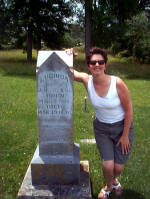 |
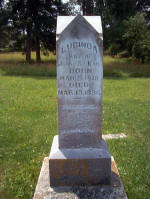 |
 |
| Lucinda
is buried in the Kay Chapel Cemetery where I took these
pictures summer of 2004. My cousin Gordon gave me a
copy of the picture of Lucinda and her husband |
| |
vi. |
Eliza Ann Austin | |
vii. |
Martha J. Austin |
Notes: Information about the estate of George Washington Austin can be found in:
The Hoosier Journal; Washington Co special page 55 Probate I Dec 1814 to May 1824 #222
Inventory of George Austin/Austin estate as appraised
4 Feb 1823 by Edmund Wayman, James Marshall and James Martin. William Watts, JP. Sale Bill 6 Feb 1823, buyers were
Francis Austin (most everything), John Jackson, Joseph M., Joseph T., and Abner Martin, Samuel C. Overton and James Roberts. Nimrod Martin, Clerk
--------------------------------
Hoosier Journal of Ancestry Washington County Special #2 page 73
Probate Record Book B 1830-1837
#4. Estate of George Austin
Nimrod Martin the administrator reports 10 Sep 1830.
-------------------
George W. Austin is listed on the 1820 census in Harrison County, IN at page 57
Austin Origin
A Coat of Arms was granted to a William Edward Osteen a parliamentary Senator and Admin Line Officer. He was an old English Patriarch of Penbrokeshire, England. Descendents descended to Scotland, Ireland, & N. Amer during the succeeding centuries. A Coat of Arms was granted in 1506.
Possibly secularized Augustinian Frairs at the time of the Reformation and dissolution of the monasteries in England - the surname is rare or even absent before 1550. Geoffrey Chaucer's Canterbury Tales speaks of someone who 'did swink and toil as Austin bit' that is as St Augustine orders. Friars of the Augustinian Order were known as Austin Friars.
Submitter: George Austin A Coat of Arms was granted to a William Edward Osteen a parliamentary Senator and Admin Line Officer. He was an old English Patriarch of Penbrokeshire, England. Descendents descended to Scotland, Ireland, & N. Amer during the succeeding centuries. A Coat of Arms was granted in 1506.
|
I have in my collection three books on the Germanna Colony:
Ancestry and Descendants of the Nassau-Siegen Immigrants To Virginia 1714-1750
The Germanna Record - The Genealogy of the Holtzclaw Family 1540-1936
The Germanna Record - No. 1 |
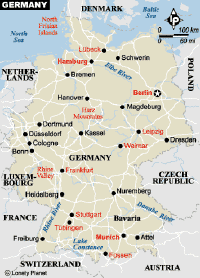
Martin, Holtzclaw, Hopwood Ancestry - Germanna Colony, Virginia
For more information on the
Germanna Colony, see their web site.
First Generation
i Merten of Ferndorf b. ca. 1510, m. Unknown.
Children:
|
i |
Mertens Heintz b. ca. 1540. |
Second Generation

Mertens Heintz b. ca. 1540, m. 1580-1609, Martins Gela. Mertens died ca. 1583, Ferndorf, Germany, buried: 1-Mar-1583.
Children:
i |
Henrich Merten b. ca. 1580. |
Third Generation
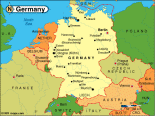
Henrich Merten b. ca. 1580, Muesen, Germany, m. 1603, Demuth Baum, (daughter of Heilmann Baum and Grete Baum). Henrich died after 1627.
Children:
i |
Sophia Merten b. ca. 1604, Muesen, Germany. |
ii |
Johannes Merten b. ca. 1606. |
Fourth Generation
Johannes Merten b. ca. 1606, m. Sophia Merten.
Children:
i |
Jacob Merten b. ca. 1634. |
Fifth Generation
Jacob Merten b. ca. 1634, Muesen, m. Margarete Eichen, (daughter of Johannes Eichen and Enchen (Anna) Schweissfurth) d. 1-Sep-1693, Muesen. Jacob died 19-Oct-1689, Muesen, Germany.
Children:
i | Elisabeth Merten b. ca. 1654. | ii | Barbara Merten b. ca. 1656. | iii | Christopher Merten b. ca 1657, d. 16-Dec 1714. | iv | Hans Jacob Merten b. ca. 1660. | v | Eustachius Merten b. ca. 1664, d. 3-Jun-1699. | vi | Jost Merten b. ca. 1667. | vii | Anna Catharina Merten b. ca. 1669. |
Sixth Generation
Hans Jacob Merten b. ca. 1660, Muesen, Germany, m. 22-Oct-1687, in Muesen, Anna Barbara Wurmback, b. ca. 1667, (daughter of Frederich Wurmbach and Margarete Rode) d. 10-Mar-1741, Muesen, German. Hans died 26-Aug-1693.
Children:
i | Eustachius Merten b. ca. 1688, d. 13-Aug-1688. | ii | Johanna Margareta Merten b. 29-Oct-1689. | iii | Johann Jost Merten b. 24-May-1691. | iv | Anna Margarete Merten b. 14-May-1693. |
Seventh Generation
Johann Jost Merten b. 24-May-1691, Muesen, Nassau-Siegen, Germany, m. (1) Maria Kathrina Otterbach, b. ca. 1699, (daughter of Hermann Otterbach and Elizabeth Heimbach) d. after 1724, m. (2) Eve ?. Johann died ca. 1759, Germantown, Virginia.
Jost (Joseph) Martin was 22 years old, and a resident of Müsen. The Martins (Merten in German) and the Brumbachs were related, so we have three of the young bachelors who were related. So, it sounds as if a third bachelor joined his two relatives in making the emigration decision. Probably all three were thinking, "Let’s try it. If it doesn’t work out, we can come back." John Spilman (Spielmann) was an older bachelor, about 34 years of age. He lived in the Oberfischbach parish, to the west of Trupbach. An occupation is unknown for this man, and when he came he seems not to have been related to any of the other members of the group. Later, this all changed as several of his relatives came to Virginia. Not much is known about him in Germany.
Children:
Eighth Generation
Joseph Martin, Born: ABT 1733 - Died: ABT 1793 - Fauquier Co. VA, Married: to Catherine Holtzclaw.
Ninth Generation
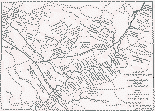 Nimrod Martin settled in the Germanna Colony of Virginia, then to Shelby County, Kentucky and then to Harrison County, Indiana. Nimrod Martin is listed in Washington County, IN on the 1820 Census at page 221. Nimrod was born about 1762 in Fauquier County, Virginia and died aobut 1832 in Lincoln County, Kentucky. He married Fanny Hopwood on 22 December 1787. Nimrod Martin settled in the Germanna Colony of Virginia, then to Shelby County, Kentucky and then to Harrison County, Indiana. Nimrod Martin is listed in Washington County, IN on the 1820 Census at page 221. Nimrod was born about 1762 in Fauquier County, Virginia and died aobut 1832 in Lincoln County, Kentucky. He married Fanny Hopwood on 22 December 1787.
Fanny Hopwood and Nimrod Martin had:
Tenth Generation
Francis Martin married George Washington Austin and had Mahulda Austin who married William Buchanon. See my Buchanon line.
Hopwood Ancestry:
Generation One
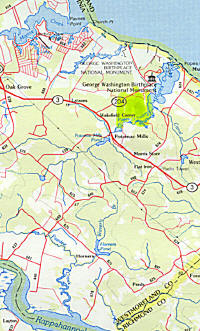
Richard Hopwood,
Born: 1682 - Westmoreland, VA, Died: 1725 - VA Married: to Mary (Unknown)
Children:
Generation Two
Moses Hopwood, Born circa 1707, father Richard Hopwood, Mother Mary (Unknown) Married:10 APR 1727 to Elizabeth Pridham. Elizabeth Pridham Born:1710 - Richmond, VA Father: Christopher Pridham Mother: Mary Lewis Married: 10 JUL 1726 to Edward Hinkley Married: 10 APR 1727 to Moses Hopwood.
Children:
Christopher A. Hopwood
Born:1732 - VA Died: ABT 1801 - Prince William Co. VA Father: Moses Hopwood Mother: Elizabeth Pridham Married: 14 FEB 1764 to Martha Combs
Children:
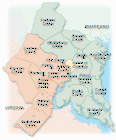
Fanny Hopwood
Born:1765 - Manassas, Prince William Co. VA Father: Christopher A. Hopwood Mother: Martha Combs Married: 22 DEC 1787 to Nimrod Martin
Children:
Frances Martin married George Washington Austin, and had Mahulda Austin who married William Buchanan and had Frances Buchanan who married John Wesley Apple and had George Thomas Apple who married
Mariah Bell and had Nancy "Jennie" Apple who married Erastus Montague and had Vivian Lucile Montague who married William Ratcliffe and had Barbara Ratcliffe who married Wendall Smith and had me!

THE HOLTZLAU‑HOLTZCLAW FAMILY
The origin of the family is from the very ancient parish of Holtzklau, first mentioned in 1089, with a parish church dating back to the 13th century in the central village of Oberholzklau, and a number of other villages in the parish, including Niederholzklau. There is a brook called the Klav (an ancient name for a gully or ravine) which runs through the parish, so that the name means "the woods of the Klav." The brook later changes its name to the Ferndorf, runs through Klafeld (the "field of the Klav"), and joins the river Sieg at Weidenau. Holzklau has always been an almost exclusively agricultural parish. The case is different wiidenau ef Weidenau, when our ancestors liv\\\
ed there, the township (Gemeinde) contained seven iron‑works settlements as well, Hardt, Muenkershuetten, Muesenershutten, Meinhardt, Schneppenkauten, Fiskenhuetten and Buschgotthardshuetten. Through marriages in the third and fourth generations of the pedigree given above, the Holzklaus of Weidenau became connected with the ironworks people there, particularly in the family of Johannes Holzklau of Weidenau, Jacob Holtzclaw's grandfather.
First Generation
Hans Henrich Hotzklau Born circa 1658 Married: to Gertrud (Patt) Solbach.
Second Generation
Hans Jacob Holtzclaw Born:1683 - Nassau-Siegen Father:Hans Henrich Hotzklau Mother:Gertrud (Patt) Solbach Married: to Anna Margreth Otterbach
Children:
Third Generation
Johannas Holtzclaw (aka John) Born:1709 - Nassau-Siegen Died:1752 - Prince William Co. VA Father: Hans Jacob Holtzclaw Mother: Anna Margreth Otterbach. Married: ABT 1730 to Catherine Thomas Russell
Children:
|
i |
Henry Holtzclaw | |
ii |
Joseph Holtzclaw | |
iii |
Elizabeth Ann Holtzclaw | |
iv |
Mary Holtzclaw | |
v |
Benjamin Holtzclaw | |
vi |
Josiah Holtzclaw | |
vii |
Catherine Holtzclaw,
4th Generation Holtzclaw, married Joseph Martin and had
Nimrod Martin who married Fanny Hopwood and had Frances Martin who married
George Washington Austin and had Mahulda Austin who married
William Buchanan and had Frances Buchanan who married John Wesley Apple and had
George Thomas Apple who married Mariah Bell and had Jennie Apple who married
Erastus Montague and had Vivian Lucile Montague who married
William Ratcliff and had Barbara Ratcliff my mom. |
|
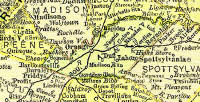 THE 1714 GERMANNA COLONISTS IN VIRGINIA THE 1714 GERMANNA COLONISTS IN VIRGINIA
Until 1815 Nassau-Siegen, now a part of Westphalia, West Germany, belonged to the House of Nassau from Holland. The Counts of Nassau had large possessions in Germany from very early times, perhaps as early as the age of Charlemagne. Siegen, the hub city of this province, is situated on the river Sieg, which flows into the Rhine from the east side. (B. C. Holtzclaw, ANCESTRY AND DESCENDANTS OF THE NASSAU-SIEGEN IMMIGRANTS TO VIRGINIA 1714-1750, Germanna Record No. Five, (Culpepper, VA: The Memorial Foundation of the Germanna Colonies in Virginia, Inc.,1964)) Siegen is 49 miles east and slightly south from Cologne; 45 miles east and slightly northeast from Bonn; and about 40 miles northeast from Coblenz; all these distances measured in air miles.
Nassau-Siegen has always been rich in iron ore, frequently very near the surface of the ground, and there is evidence to show that there was active production of iron in this principality from 500 B.C. to about 100 A.D., carried on by early inhabitants, who were probably Celts. For some reason this activity seems to have ceased during the early years of the Christian era, possibly because the earlier inhabitants were driven out by Germans. From the time of Charlemagne and the Franks, however, there are numerous evidences of iron production by the so-called forest smiths. That Nassau-Siegen was famous for the production of iron even in the early years is evidenced by the fact that in a Welsh poem of the 12th century, written by Geoffrey of Monmouth, the home of the legendary Wieland the Smith of the Arthurian saga, is located in the city of Siegen. There is a village in the south of Nassau-Siegen called Wilnsdorf, which in the middle ages was called "Wilandisdorf", or village of Wieland.
During the 13th century the iron industry was revolutionized in Nassau-Siegen by the discovery that water power could be used to operate the smelters and drive the hammers that worked the iron further. The Count and the nobility were at first active in founding such water-powered ironworks, but they very soon passed into the hands of worker-owners, who banded together in the Guild of Smelterers and Hammersmiths, The members of this Guild mostly lived in the country near their plants, unlike most of the members of others guilds who lived in the cities. Due to a lack of water power in the dry seasons and to a frequent scarcity of charcoal needed for heating the ore and pig iron, the ironworks could not be operated continuously throughout the year. Thus the ironworks owners nearly always farmed in addition to their work in iron. Also the farmers frequently became part owners of the iron works, through intermarriage. (B.C.Holtzclaw, ANCESTRY AND DESCENDANTS OF THE NASSAU-SIEGEN IMMIGRANTS TO VIRGINIA 1714-1750, Germanna Record No. Five,( Culpeper, VA: The Memorial Foundation of the Germanna Colonies in Virginia, Inc.,1964))
Three German groups of colonists came to Virginia during Governor Spotswood's administration and settled at or near what became Germanna. The first group consisted of 12 families numbering 42 persons, as shown by an order of the Virginia Council, passed April 28, 1714. Included in this group were some of our direct ancestors, as follows: Hans Jacob Holtzclaw. his wife Margaret ,their son John Holtzclaw , and Peter Hitt.
 The settlers at Germanna in 1714 were fairly well educated people by the standards of the time. Compulsory schooling was introduced in Nassau-Siegen in the middle of the 16th century. All of this colony excepting Haeger and Holtzclaw, were raised on farms, and undoubtedly farmed land owned by them when they emigrated. Farm work was done by the women and children and at special seasons by the men who were taught mining and iron-making. The settlers at Germanna in 1714 were fairly well educated people by the standards of the time. Compulsory schooling was introduced in Nassau-Siegen in the middle of the 16th century. All of this colony excepting Haeger and Holtzclaw, were raised on farms, and undoubtedly farmed land owned by them when they emigrated. Farm work was done by the women and children and at special seasons by the men who were taught mining and iron-making.
The original Germanna settlement consisted of a fort, furnished with two cannon, including ammunition, and a road cleared to the settlement. This settlement not only served as living quarters for these colonists who were to work in Governor Spotswood's ironworks , but was also regarded as security for the Virginia frontier from Indian attacks. It was located on a peninsula on the south side of the Rapidan River, which is the southern (more properly the western) branch of the Rappahannock, nine miles above the confluence with the northern branch and 13 miles above the site of Governor Spotswood's iron works.
The twelve families of the 1714 colony finished their work for Governor Spotswood in December 1718. Apparently they felt that they were being imposed upon by the Governor and wished to take advantage of the opportunities for bettering their lot in their new country. Therefore, sometime in 1718 John Fishback, John Hoffman, and Jacob Holtzclaw, the three members of the colony who had been naturalized, made an entry of approximately 1800 acres of land in the Northern Neck of Virginia. There a settlement was eventually founded which became known as Germantown. The colonists probably moved to their new location sometime in 1719; however, the actual patent for Germantown was not made until August 22, 1724, due to the death of Lady Fairfax. Germantown, which no longer exists , was located in what is now Fauquier County, Virginia.
The Memorial Foundation of the Germanna Colonies, Inc., Box 693, Culpeper, Va. 22701, established in 1956, purchased the original site of Germanna Colony and has instituted an archeological dig on this site. The Corporation owned 270 acres, "Siegen Forest," of the original Germanna tract. That acquisition of the property was made possible by the generosity of one of the trustees of the Foundation. Approximately 100 acres of this was given in 1969 to the State of Virginia for the erection of the Germanna Community College. By authority of the Virginia State Highway Commission, issued March 26, 1969, Virginia Route #3 from Culpeper to Fredericksburg has been designated GERMANNA HIGHWAY. This highway borders "Siegen Forest" and traverses the area where the first colony of 1714 was settled by Governor Spotswood.
The Foundation has published 13 different Germanna Records containing a wealth of information on the colonists, including much on the Hitts and the Holtzclaws. All of the information included in this genealogy on Germanna Colony and the ancestry of the Hitts and the Holtzclaws which follows was obtained from the following Germanna Records:
Holtzclaw, B.C. Peter Hitt, John Joseph Martin, and Tillman Weaver of the 1714 Colony and heir descendants, Germanna Record No.1
Holtzclaw, B.C. and Hackley, W.B. Germantown Revived., Germanna Record No. 2.
Holtzclaw, B.C. Ancestry and Descendants of the Nassau-Siegen immigrants of Virginia, 1714-1750. Germanna Record No. 5.
Holtzclaw, B.C. and Wayland, John W. Germanna, Outpost of Adventure. Germanna Record No.7.
For more information on the Nassau- Siegen immigrants to Virginia, I highly recommend the above publications for further reading. |
The Germanna Colony of 1717
On July 12, 1717, twenty families left the area that would become Germany to go to the New World of North America. Their boat was detained in England, where the captain was imprisoned for debt. Because they were delayed while waiting for his release, their provisions ran so low that many of them perished during the crossing.
They had planned to join other German families in Pennsylvania, but storms forced the ship south, to Virginia. There the English sea captain claimed that they had not paid for their passage and refused to let them land until Gov. Alexander Spotswood paid him the amount he demanded. Spotswood, in turn, managed to get the Germans to
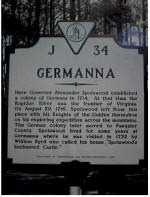 sign a contract that "they apparently did not fully understand." Thus members of the 1717 Germanna Colony came to America as indentured servants. Further, at the end of the customary seven-year period, Spotswood sued and compelled most of them to work an additional year, "so that they labored eight years to gain their freedom." Read more about this family (Martin and the Germanna Colony here, courtesy of George Austin. sign a contract that "they apparently did not fully understand." Thus members of the 1717 Germanna Colony came to America as indentured servants. Further, at the end of the customary seven-year period, Spotswood sued and compelled most of them to work an additional year, "so that they labored eight years to gain their freedom." Read more about this family (Martin and the Germanna Colony here, courtesy of George Austin.
The Germanna Colonies, John Blankenbaker
 In 1713, forty-odd Germans left their homes in Nassau-Siegen expecting to mine silver in the New World. In 1717, about eighty Germans left their homes in southwest Germany expecting to go to Pennsylvania. Neither of these groups fulfilled its expectations. Instead, they became guardians of the frontier in Virginia and a vanguard in the westward expansion of English civilization on the North American continent. How did this come about, especially when the Germans themselves had no expectations of serving in these capacities? In 1713, forty-odd Germans left their homes in Nassau-Siegen expecting to mine silver in the New World. In 1717, about eighty Germans left their homes in southwest Germany expecting to go to Pennsylvania. Neither of these groups fulfilled its expectations. Instead, they became guardians of the frontier in Virginia and a vanguard in the westward expansion of English civilization on the North American continent. How did this come about, especially when the Germans themselves had no expectations of serving in these capacities?
Reviewing the events prior to the coming of the Germans, the Colony of Virginia had settled Huguenots on the James River as a buffer between the English and the Indians. Franz Michel in Switzerland wondered if the Swiss might not do the same thing in Virginia and establish colonies where they could send people, including Anabaptists whom they did not desire in Switzerland. Michel went to Virginia where he explored the possibilities. He liked what he saw and heard. Back in Bern, he reported to his partners who unsuccessfully attempted to obtain a concession for a Swiss colony from Queen Anne of England. Michel, meanwhile, returned to America for several years of further exploration. The Swiss entrepreneurs were approaching this venture as an opportunity to earn money. There were no altruistic motives.
The reports of Michel inflamed Christoph von Graffenried of Bern who was looking for a way to restore his status and financial health. Graffenried was especially intrigued by Michels report that he had found silver mines. Graffenried joined Michels company (Georg Ritter and Company) and provided the necessary spark to ignite action. Though colonization was the primary objective, silver mining was promoted to equal importance.
By a coincidence, this was the year, 1709, when so many Germans were in London expecting that Queen Anne would provide transportation for the emigrants who wanted to go to the English colonies.
The proprietors of North Carolina had obtained permission to send several hundred of the thousands of Germans in London to their colony. These proprietors agreed to provided transportation for an initial group of Swiss if Graffenried would be responsible for the Germans they were sending over. Believing he could pursue the dual objectives of colonization and silver, Graffenried agreed to lead the several hundred Germans and a smaller contingent of Swiss to North Carolina.
The silver mining was pursued by hiring Johann Justus Albrecht to purchase tools and to recruit German miners. To find the miners, Albrecht went to Siegen where there were iron mines. Graffenried thought that the North Carolina colony could be set up rather quickly and then he could devote his attention to the silver mines in Virginia. Graffenried's company had obtained the Queens approval for land in Virginia for a Swiss colony. There was no intention now to use Swiss citizens since the German miners were to live there.
In America, many misfortunes befell Graffenried. He was even lucky to escape what seemed like a certain death at the hands of the Indians. The German/Swiss colony did not prosper in these early years. Graffenried and Michel had a disagreement before Michel had shown Graffenried the location of the silver mines. Graffenried went to Virginia to see if he could find a site where he could relocate the remainder of the North Carolina colony and to see if he could find the silver mines. While he was there, he aroused the attention of Lt. Gov. Alexander Spotswood. Spotswood even invested significantly in what seemed to be a silver mine.
Graffenried had to give up in America as the colonization enterprise was bankrupt. He returned to Europe in 1713 and when he passed through London he found that Albrecht was there with forty-odd people from the Siegen area who were expecting to have the balance of their trip to the colonies financed by Graffenried. No report tells us clearly why the Germans had been motivated to go to London at this time. Graffenried, being broke, could only advise them to go home. They did not feel they could do this as they were citizens without a country. Instead, the Germans agreed to pay a part of their transportation costs and to work four years to pay for the balance. The agent for Virginia in London obligated Spotswood to pay this balance even though Spotswood himself knew nothing of the agreement.
This agent in London, Nathaniel Blakiston, was very much aware that Spotswood was interested in precious metals. He appeared on Spotswood's behalf before the Board of Trade and before Lord Orkney who was the nominal governor of Virginia. He pleaded for a resolution of the question of the royal percentage if precious metals were found. Because of Blakiston's knowledge of Spotswood's interest in these precious metals, he felt that the Germans were a good opportunity for Spotswood to obtain the labor he might be needing.
After the Germans were in Virginia, Spotswood welcomed them in the hope that they could be put to work in the projected silver mine of which he was a quarter owner. This mine was about fifteen miles beyond the western extent of English civilization so Spotswood obtained the concurrence of the Virginia Council to build a fort from the public monies for the Germans. The official explanation was that the Germans were to be the guardians of the frontier to protect the English from the Indians. They did serve in this capacity. From the land plots, one can see that the mine which seemed to have silver was only about four miles from the German settlement. As with many of Spotswood's actions, it is hard to distinguish between the public policy which he was helping to formulate and his personal interests.
Because the status of foreigners was uncertain, Spotswood was afraid that his actions might be held against him. Perhaps the naming of the fort as Germanna was a subtle appeal to Queen Anne who was favorably inclined toward Germans.
Spotswood would not allow the Germans to work in the mine until the legal title to precious metals was clarified. Therefore, the Germans did no mining for two years while instead they farmed and guarded the frontier. Eventually an attempt was made to locate silver ores but the mine was abandoned because none could be found.
Spotswood was looking for a means to insure his economic future which, as Lt. Governor, was not secure. Observing how other people in Virginia had prospered, he decided on a course of land acquisition. Most of the land in the Tidewater region had been taken up and the large tracts were all in the Piedmont to the west where there were no settlements and no roads but there were Indians. This was the best available land in the period from 1710 to 1720, especially in large tracts. This land had never been patented to private owners by the Crown and it was available relatively cheaply.
Once a private individual took up the land, he had to make improvements and to settle a certain number of people. The western lands could be raided easily by the Indians which would discourage settlers. No one wanted to be first and risk his own safety. Spotswood saw that the answer lay in obtaining a large number of people who could be settled at the same time. Their safety would be provided by their own numbers and they would provide the settlers to make a valid claim to a large tract.
The Fort Germanna Germans had done a good job in keeping the peace without creating any problems for the Virginians. Spotswood envisioned that the people he wanted and needed could be Germans.
In conversations with the captains of ships, he let them know he wanted a whole shipload of Germans. One of them, Andrew Tarbett, when he was back in England, agreed to take about eighty Germans to Pennsylvania which was where they wanted to go. Instead, he took them to Virginia on the ship Scott where he sold them as servants to Spotswood and his partners. They were settled on a tract of 40,000 acres of land (40,000 acres was the official description but the tract was closer in size to 65,000 acres) starting to the west of Germanna.
The Germans in the fort had been the western- most point of English civilization on the Atlantic seaboard. After the second group came, they were the most western point of English civilization even though, in both cases, the language and customs were German.
The first group of Germans, the miners from Nassau-Siegen, lived in the fort and worked about four years for Spotswood. During the first two years they cleared land and farmed, then for about two and half years, they worked in mining and quarrying, first at the silver mine and then with the iron ores which they had discovered. Early in 1719, they moved north to land they had purchased in the Northern Neck, just south of
today's Warrenton. Before they left the employment of Spotswood, they had found and developed iron mines but they did not build an iron furnace for Spotswood. This group, which became known as the First Germanna Colony, was German Reformed by religion.
The Second Germanna Colony came from many different villages which were mostly south and east of Heidelberg with a few from outside this area. They worked seven years for Spotswood and his partners in naval stores projects and in vineyards. When they did move, they went about twenty-five miles farther west to land in the Robinson River Valley at the foot of the Blue Ridge Mountains. This again was an extremely exposed position but they chose this general region because land there was free at the time and there were few or no English settlers which gave them space for expansion. By religion they were predominantly Lutheran. In 1740, they built a church which is still being used today as a Lutheran church (it is now the oldest building in the Americas still in use as a Lutheran church).
Even before the Germans had left the vicinity of Fort Germanna, more Germans were coming. After the Germans had left the neighborhood of Fort Germanna, the newcomers moved directly to the regions where the earlier Germans were then living. These newcomers had a mixed background. Some of them had been in the English colonies for a few years and were relocating. Others came directly from Germany. Many were friends and relatives of those already here. This process continued until and after the Revolution. During the war, some of the British auxiliaries from Germany thought that farming in a German community was better than carrying a musket for the British. All of these people are called the Germanna Colonists even though the majority of them were never at Germanna and they were not members of any colony. Essentially, the common characteristic was that they lived on the east side of the Blue Ridge Mountains. The name Germanna Colonist is used because it was appropriate for the first of the Germans.
The process of finding the Germans who lived in this general region is ongoing. New names are being uncovered. Work continues also in extending their history in Europe including locations in Germany, Switzerland, and Austria.
Because many of the activities bearing on the early Germanna citizens were semi-official, there is considerable recorded history about them. Major sources of family information pertaining to the Second Colony people are their church records where there are baptismal records from 1750 to the early 1800s and communion lists from 1775 to 1812.
There is a sense of community identity among all of the Germanna people which still exists.
(Reprinted from Volume 14, number 3, (May 2002), Beyond Germanna)
Here the miners dismount in what is the westernmost point of settlement in the Virginia colony and begin to build a five-sided log fort (similar to the one at Jamestown which was built in 1607--a hundred years before).
These German immigrants establish the first settlement of the Virginia Piedmont and of what will become Orange County. It is also the oldest German settlement in the New World. This settlement is christened "Fort Germanna" both in recognition of its German settlers and to honor Queen Anne (also called "Anna"). (The Rapidan River is also named for Queen Anne: "rapid" plus "an" for "Anne"--sometimes it is written as "Rapid Ann" and "Rapidanne" in this period.)
The family names of these pioneer German families prosper in America and figure prominently in the many American German ancestry genealogical societies today:
Jacob Holtzclaw, wife Margaret, sons John and Henry
John Joseph Martin, wife Maria Kathrina
John Spillman, wife Mary
Herman Fishback, wife Kathrina
John Hoffman, wife Kathrina
Joseph Coons, wife Kathrina, son John Annalis, daughter Kathrina
John Fishback, wife Agnes
Jacob Rector, wife Elizabeth, son John (ancestor of the author's wife on her mother's side)
Melchior Brumback, wife Elizabeth
Tillman Weaver, mother Ann Weaver
Peter Hitt, wife Elizabeth
Rev. John Henry Hager
John Kemper
Harman Utterback
The descendants of these German pioneers spread out across the entire country during the decades of westward expansion that follow, and five become state governors:
James Lawson Kemper (Virginia)
James Sevier Conway (Arkansas)
Elias Nelson Conway (Arkansas)
Henry Massey Rector (Arkansas)
William Meade Fishbach (Arkansas) ("Germanna History" online 2)
This fort is intended to protect the Virginia frontier and serve as a buffer against the Indians. Thanks to a description of it made in a diary by a visiting British officer, JOHN FONTAINE (who is touring the area with an interest to buying land), we know the fort has two cannons (supplied by Spotswood), nine houses (one for each of the miners with a family); small compounds around each house with outbuildings for livestock, and a central blockhouse that serves as the last point of defense if the fort is overrun. This blockhouse doubles as a church—the first congregation of the German Reformed Church in America. Their pastor is the Reverend John Henry Hager, who is born in Anzhausen in 1644 and thus is 70 years old when he arrives in Virginia in 1714. (A man of "great erudition," he dies in 1737 in Madison County, Virginia, at age 93, this according to Wayland 12.)
Here is John Fontaine's description, from his entry of 21 November 1715 of his visit to Fort Germanna:
We walked about the town, which is palisaded with stakes stuck in the ground, and laid close the one to the other, and of substance to bear out a musket-shot. There are but nine families, and they have nine houses, built all in a line; and before every house, about twenty feet distant from it, they have small sheds built for their hogs and hens, so that the hog-sties and houses make a street. The place that is paled in is a pentagon, very regularly laid out; and in the very centre there is a black-house, made with five
sides, which answer to the five sides of the great
enclosure; there are loop-holes through it, from which you may see all the sides of the inclosure. This was intended for a retreat for the people, in case they were not able to defend the palisades, if attacked by the Indians.
They make use of this block-house for divine service. They go to prayers constantly once a day, and have two sermons on Sunday. We went to hear them perform their service, which was done in their own language, which we did not understand; but they seemed to be very devout, and sang the psalms very well. (qtd. in Wayland 25).
|

